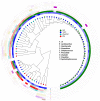Diverse vaginal microbiomes in reproductive-age women with vulvovaginal candidiasis
- PMID: 24265786
- PMCID: PMC3827160
- DOI: 10.1371/journal.pone.0079812
Diverse vaginal microbiomes in reproductive-age women with vulvovaginal candidiasis
Abstract
Vulvovaginal candidiasis (VVC) is one of the most prevalent vaginal infectious diseases, and there are controversial reports regarding the diversity of the associated vaginal microbiota. We determined the vaginal microbial community in patients with VVC, bacterial vaginosis (BV), and mixed infection of VVC and BV using Illumina sequencing of 16S rRNA tags. Our results revealed for the first time the highly variable patterns of the vaginal microbiome from VVC patients. In general, the alpha-diversity results of species richness and evenness showed the following order: normal control < VVC only < mixed BV and VVC infection < BV only. The beta-diversity comparison of community structures also showed an intermediate composition of VVC between the control and BV samples. A detailed comparison showed that, although the control and BV communities had typical patterns, the vaginal microbiota of VVC is complex. The mixed BV and VVC infection group showed a unique pattern, with a relatively higher abundance of Lactobacillus than the BV group and higher abundance of Prevotella, Gardnerella, and Atopobium than the normal control. In contrast, the VVC-only group could not be described by any single profile, ranging from a community structure similar to the normal control (predominated with Lactobacillus) to BV-like community structures (abundant with Gardnerella and Atopobium). Treatment of VVC resulted in inconsistent changes of the vaginal microbiota, with four BV/VVC samples recovering to a higher Lactobacillus level, whereas many VVC-only patients did not. These results will be useful for future studies on the role of vaginal microbiota in VVC and related infectious diseases.
Conflict of interest statement
Figures




Similar articles
-
Correlation Analysis of Vaginal Microbiome Changes and Bacterial Vaginosis Plus Vulvovaginal Candidiasis Mixed Vaginitis Prognosis.Front Cell Infect Microbiol. 2022 Mar 8;12:860589. doi: 10.3389/fcimb.2022.860589. eCollection 2022. Front Cell Infect Microbiol. 2022. PMID: 35372135 Free PMC article.
-
Vaginal microbiota of asymptomatic bacterial vaginosis and vulvovaginal candidiasis: Are they different from normal microbiota?Microb Pathog. 2019 Sep;134:103599. doi: 10.1016/j.micpath.2019.103599. Epub 2019 Jun 15. Microb Pathog. 2019. PMID: 31212037
-
Interpretation of vaginal metagenomic characteristics in different types of vaginitis.mSystems. 2024 Mar 19;9(3):e0137723. doi: 10.1128/msystems.01377-23. Epub 2024 Feb 16. mSystems. 2024. PMID: 38364107 Free PMC article.
-
Vaginosis: Advances in new therapeutic development and microbiome restoration.Microb Pathog. 2022 Jul;168:105606. doi: 10.1016/j.micpath.2022.105606. Epub 2022 May 26. Microb Pathog. 2022. PMID: 35644292 Review.
-
Lactobacilli-containing vaginal probiotics to cure or prevent bacterial or fungal vaginal dysbiosis: a systematic review and recommendations for future trial designs.BJOG. 2020 Jan;127(2):287-299. doi: 10.1111/1471-0528.15870. Epub 2019 Aug 8. BJOG. 2020. PMID: 31299136
Cited by
-
Cervicovaginal Fungi and Bacteria Associated With Cervical Intraepithelial Neoplasia and High-Risk Human Papillomavirus Infections in a Hispanic Population.Front Microbiol. 2018 Oct 23;9:2533. doi: 10.3389/fmicb.2018.02533. eCollection 2018. Front Microbiol. 2018. PMID: 30405584 Free PMC article.
-
Novel high-resolution targeted sequencing of the cervicovaginal microbiome.BMC Biol. 2021 Dec 16;19(1):267. doi: 10.1186/s12915-021-01204-z. BMC Biol. 2021. PMID: 34915863 Free PMC article.
-
It Takes Two to Tango: How a Dysregulation of the Innate Immunity, Coupled With Candida Virulence, Triggers VVC Onset.Front Microbiol. 2021 Jun 7;12:692491. doi: 10.3389/fmicb.2021.692491. eCollection 2021. Front Microbiol. 2021. PMID: 34163460 Free PMC article. Review.
-
An Omics Perspective on Candida Infections: Toward Next-Generation Diagnosis and Therapy.Front Microbiol. 2016 Feb 16;7:154. doi: 10.3389/fmicb.2016.00154. eCollection 2016. Front Microbiol. 2016. PMID: 26909070 Free PMC article. Review.
-
The Vaginal Microbiota, Bacterial Biofilms and Polymeric Drug-Releasing Vaginal Rings.Pharmaceutics. 2021 May 19;13(5):751. doi: 10.3390/pharmaceutics13050751. Pharmaceutics. 2021. PMID: 34069590 Free PMC article. Review.
References
-
- Wilson BA, Thomas SM, Ho M (2011) The human vaginal microbiome. Metagenomics of the Human Body: Springer. pp. 91–115.
Publication types
MeSH terms
Substances
LinkOut - more resources
Full Text Sources
Other Literature Sources

